Unit 5 First aid for burns Reading课件(31张PPT)
文档属性
| 名称 | Unit 5 First aid for burns Reading课件(31张PPT) | 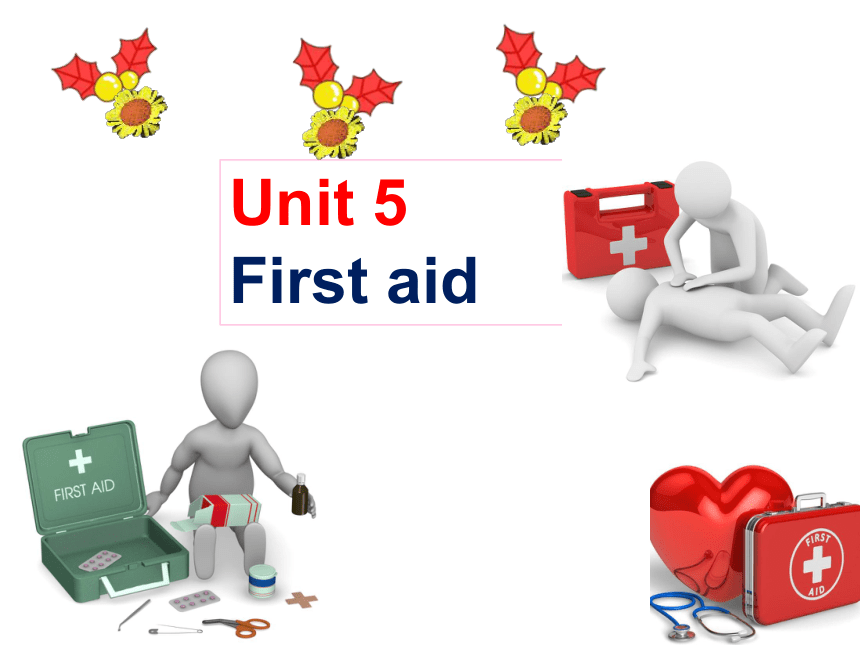 | |
| 格式 | zip | ||
| 文件大小 | 4.3MB | ||
| 资源类型 | 教案 | ||
| 版本资源 | 人教版(新课程标准) | ||
| 科目 | 英语 | ||
| 更新时间 | 2020-03-15 11:53:49 | ||
图片预览

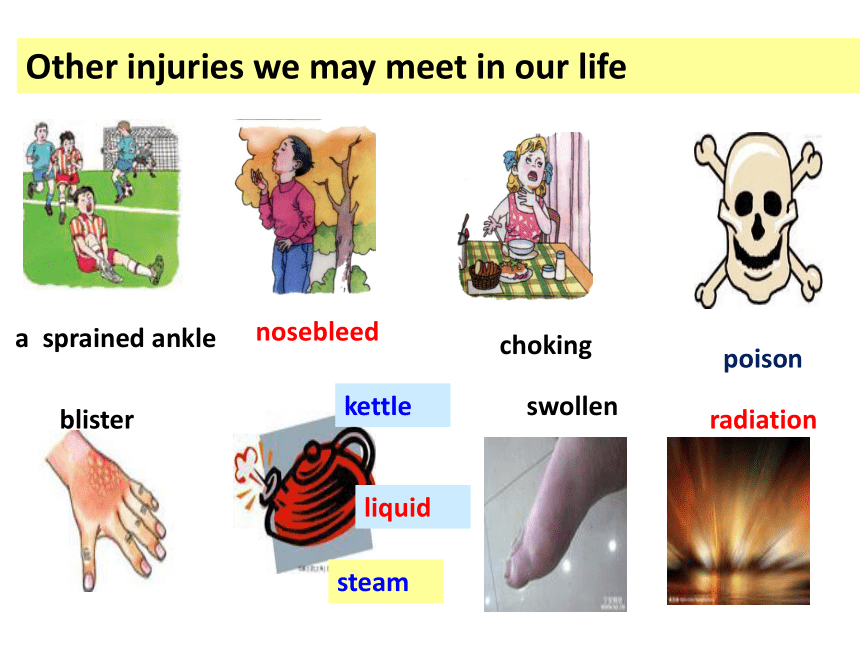
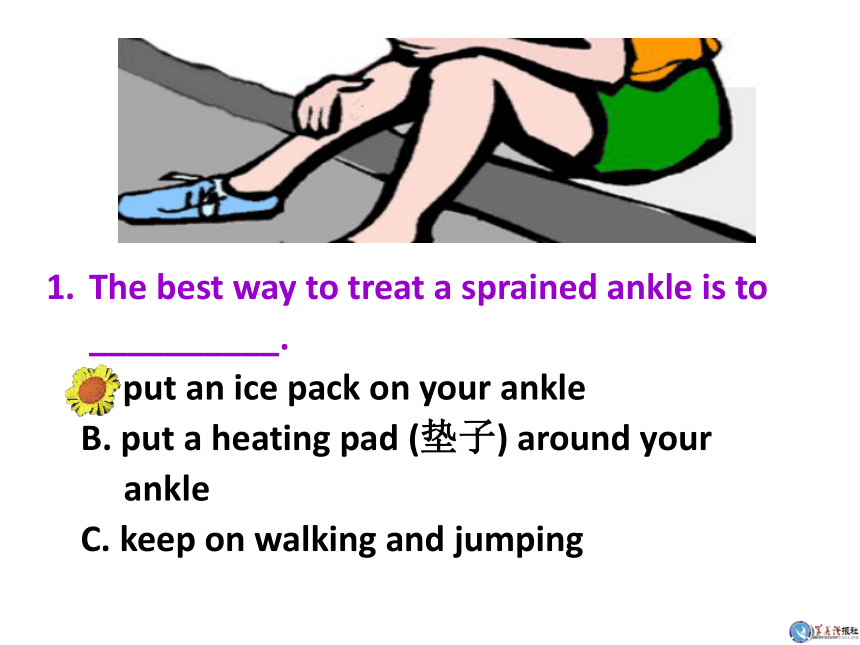
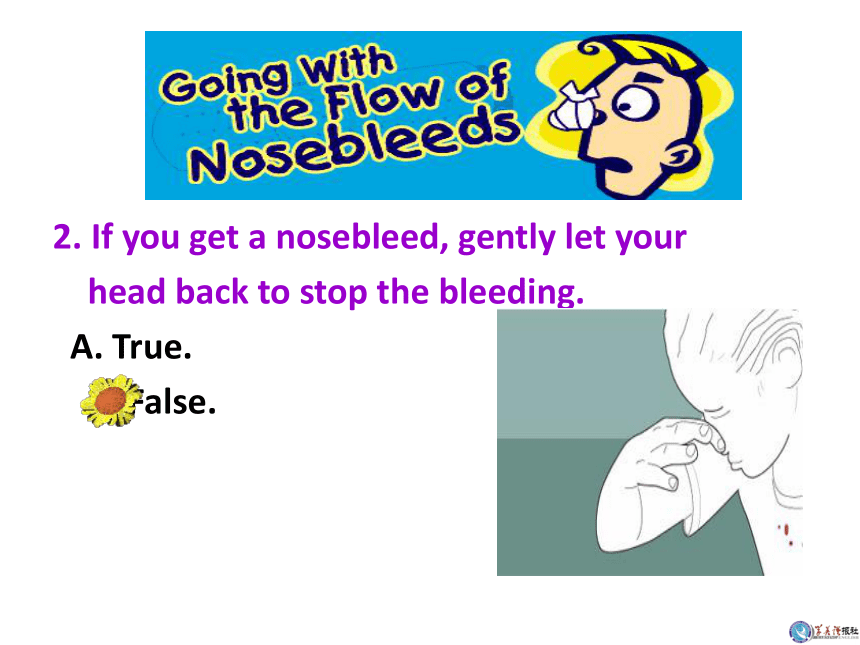
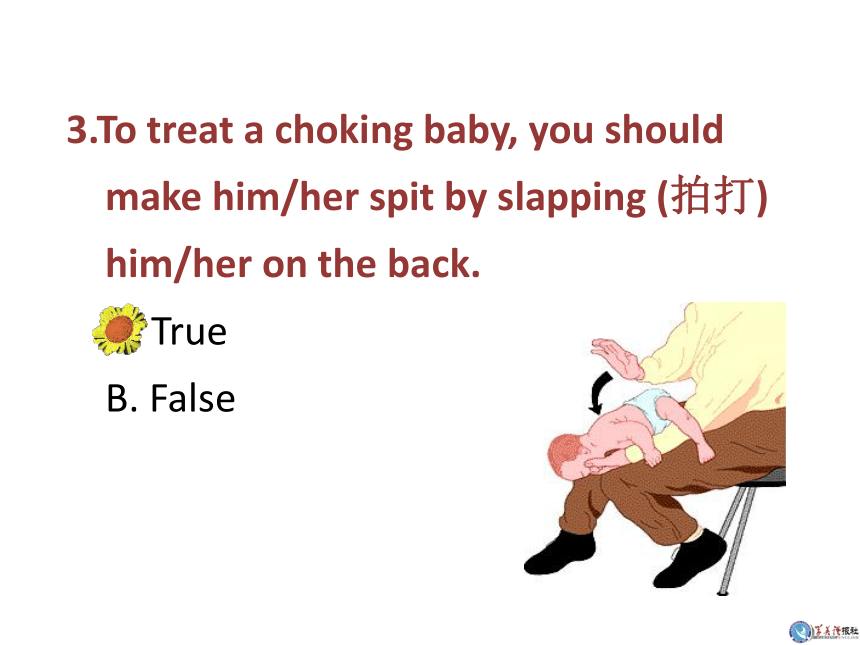
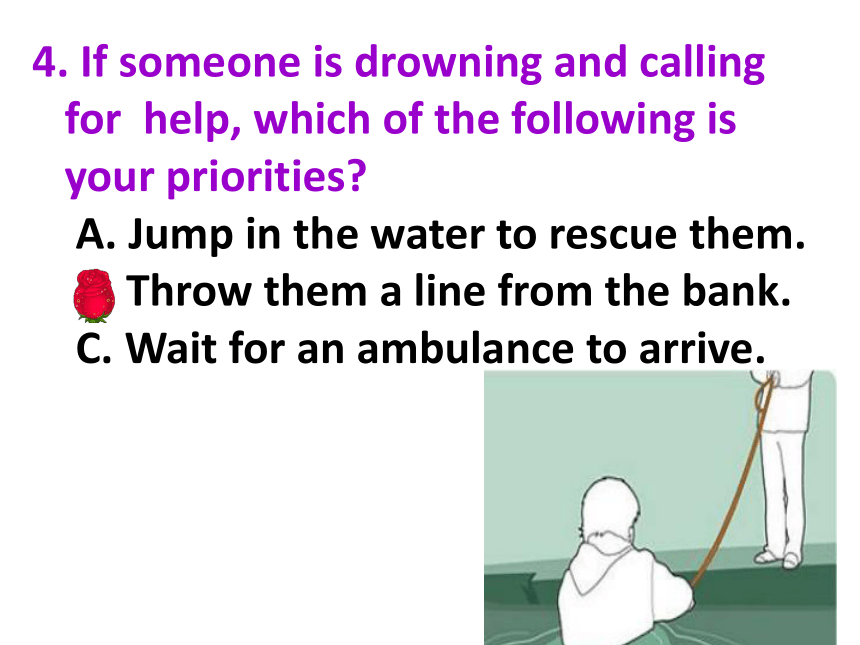
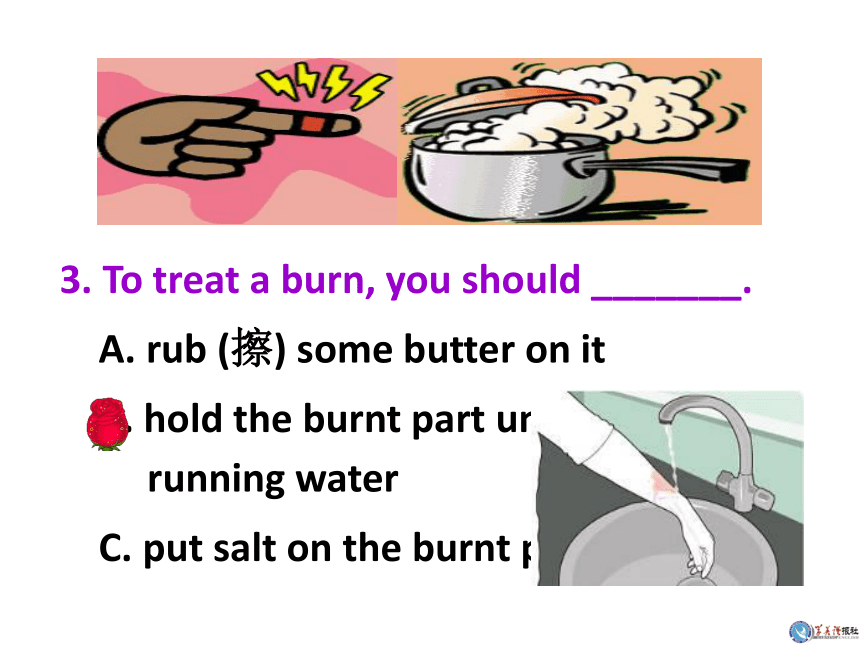
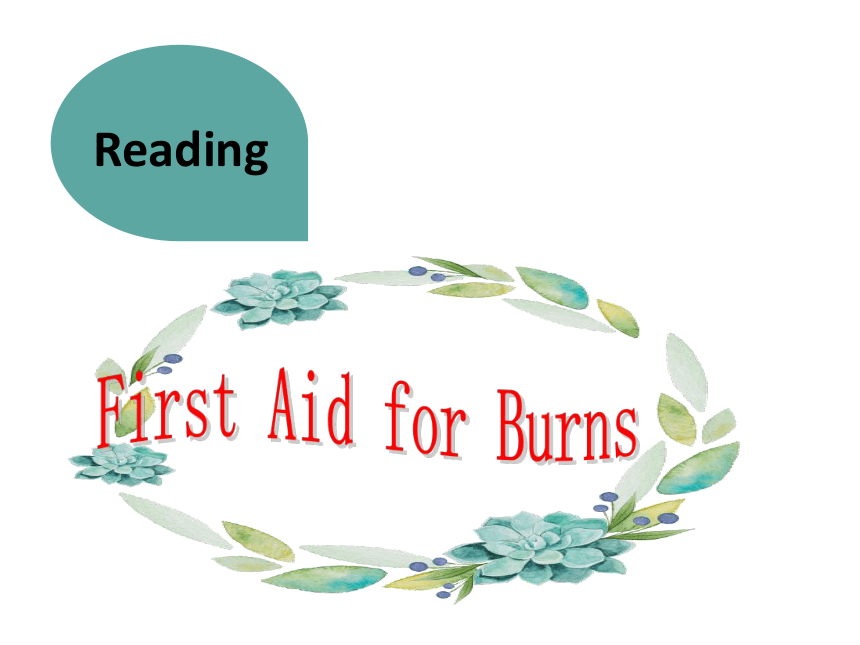
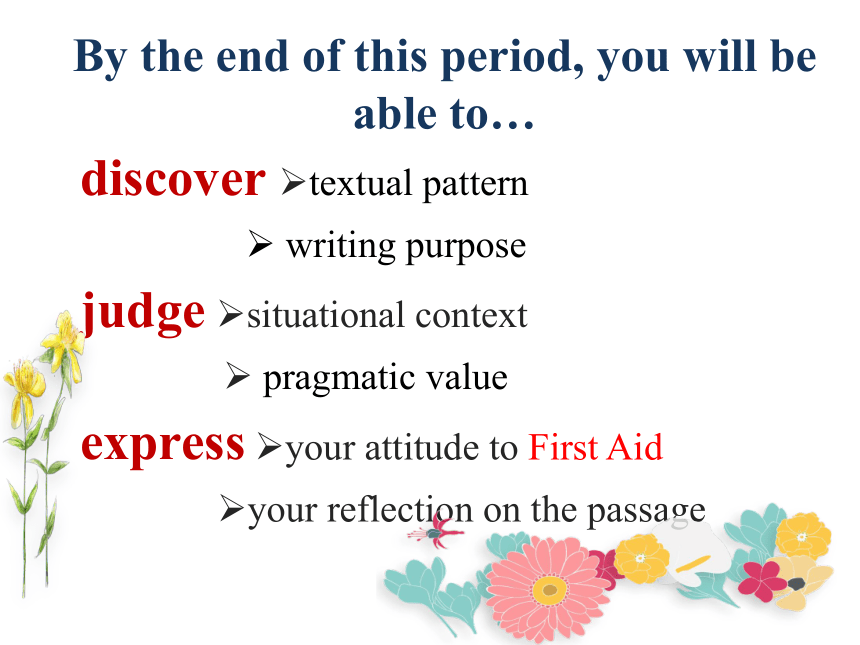

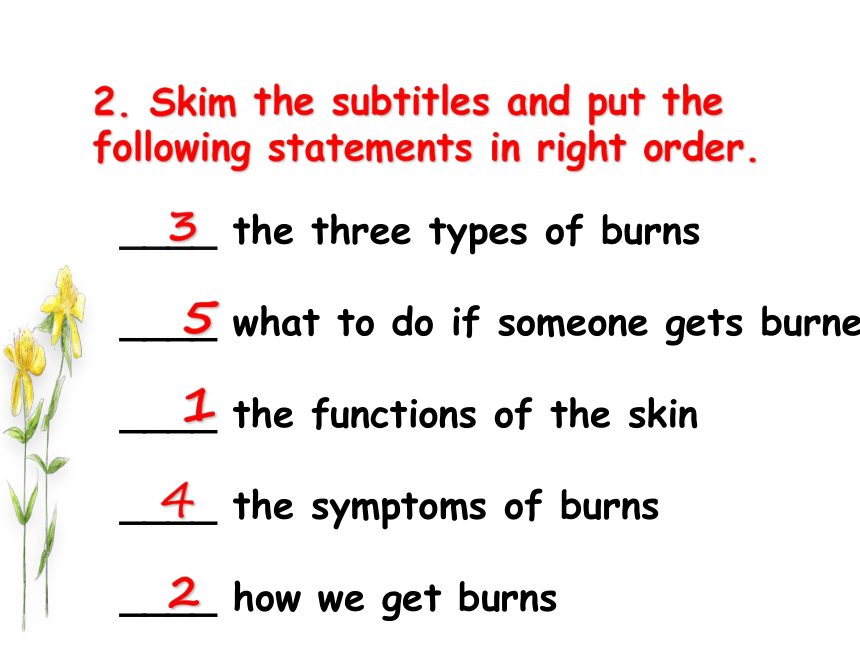
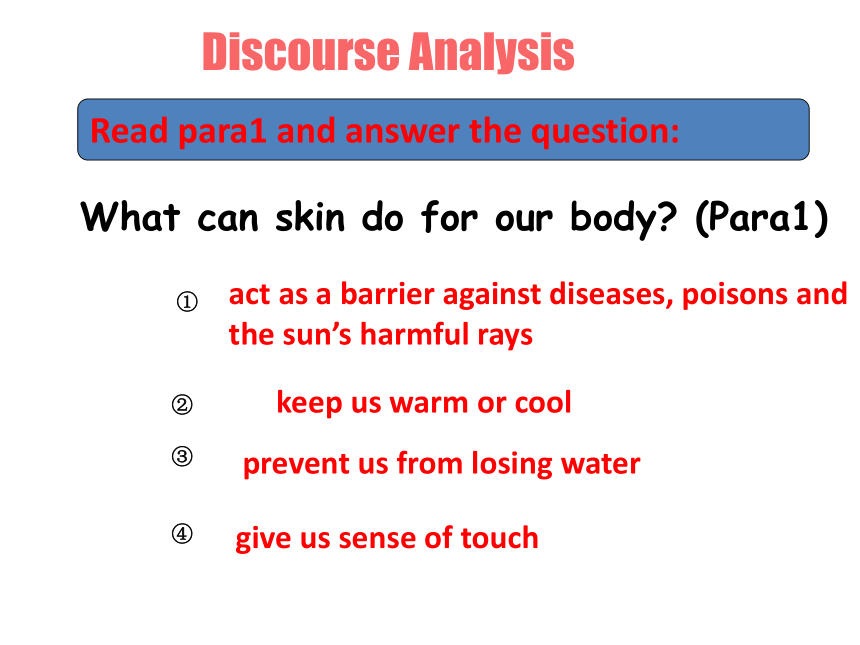
文档简介
(共31张PPT)
Unit 5
First aid
Other injuries we may meet in our life
2
4
6
9
10
a sprained ankle
nosebleed
choking
poison
blister
kettle
liquid
steam
swollen
radiation
The best way to treat a sprained ankle is to __________.
A. put an ice pack on your ankle
B. put a heating pad (垫子) around your
ankle
C. keep on walking and jumping
2. If you get a nosebleed, gently let your
head back to stop the bleeding.
A. True.
B. False.
3.To treat a choking baby, you should
make him/her spit by slapping (拍打)
him/her on the back.
A. True
B. False
4. If someone is drowning and calling for help, which of the following is your priorities?
A. Jump in the water to rescue them.
B. Throw them a line from the bank.
C. Wait for an ambulance to arrive.
3. To treat a burn, you should _______.
A. rub (擦) some butter on it
B. hold the burnt part under cold
running water
C. put salt on the burnt part
First Aid for Burns
Reading
By the end of this period, you will be able to…
discover ?textual pattern
? writing purpose
judge ?situational context
? pragmatic value
express ?your attitude to First Aid
?your reflection on the passage
Textual analysis
Where do you think the passage is from? Why do you think so?
It may come from a medical magazine.
Because it tells us some information
about first aid treatment.
2. Skim the subtitles and put the following statements in right order.
____ the three types of burns
____ what to do if someone gets burned
____ the functions of the skin
____ the symptoms of burns
____ how we get burns
3
5
1
4
2
What can skin do for our body? (Para1)
①
②
③
④
Discourse Analysis
give us sense of touch
act as a barrier against diseases, poisons and the sun’s harmful rays
keep us warm or cool
prevent us from losing water
Read para1 and answer the question:
Para.2. How can we get burnt?
R
e
a
d
i
n
g
We can get burnt by :
hot liquids
steam
fire
the sun
electricity
chemicals
radiation
the three layers of skin:
The third layer
The second layer
The top layer
First degree burns
Affect the _______ of the skin. Dry, red and mildly
______. _______ painful. Turn white when ______.
Second degree burns
Affect both the ____ & the ______ layer. ________, red and swollen. Extremely painful. ________ watery surface
Third degree burns
Affect________ layers of the skin. Black and white and _______. ______ or ____ pain. may be pain around____________________ Swollen;
_____can
be seen.
Types & characteristics of burns(based on para3&4)
Types Characteristics
top layer
top
second
all three
swollen
Rough
tissue
Mildly
Little
no
pressed
Blisters
charred
edge
of injured
area
Types of burns
Characteristics
second degree burn:
first degree burn
third degree burn :
mildly swollen
blisters
extremely
painful
often tissue
under them can
be seen
Read Para 5 carefully and do the following two exercises:
Treatment Dos
______ clothing and jewellery near the burns.
______ the burns with cool water.
___ cool, clean wet cloths on the burns.
______ the burned area gently.
______ the burned area with a dry clean bandage.
______ the burned area ______ than the heart, if possible. If burns are on the face, the victim should________.
____ the victim ____the doctor or hospital, if possible.
Take off
Place
Dry
Cover
Keep
Get
to
higher
Cool
sit up
Exercise 1
Treatment Don’ts
1). Do not _______ the clothing that is stuck to the burns.
2). Do not cool the burns with ____ water.
3). Do not put cold water on _____ degree burns.
4). Do not ____ the burns, it may break the blisters.
5). Do not ____ butter, oil or ointment on burns.
remove
icy
third
rub
put
Tell right from wrong;
Exercise 2
Sam
knocked over a kettle full of
boiling water onto his legs.
legs became red, swollen and
covered with blisters. Sam
broke the blisters
and poured icy water
from the fridge
onto the skin.
Based on this, we can know his burn belongs to second degree burns.
Sam shouldn’t have broken the blisters because the burns could become infected.
Sam shouldn’t have poured icy water but cool water on the burn.
W
Tell right from wrong;
Exercise 2
2. While ironing
clothes, Miss Good accidentally
touched the iron. Her wrist blistered
and became watery. It hurt a lot. She
put her wrist under the cold water
tap
and then kept placing cool,
clean, damp cloths on it
until it was less painful.
Then she went to
see the doctor.
Based on this, we can know his burn belongs to second degree burns.
R
Tell right from wrong;
Exercise 2
3. Mrs Casey’s sleeve caught fire
while she was cooking. Her arm looked
terrible but it didn’t hurt. The skin was
charred. Her husband took off her blouse
and picked off bits of the blouse stuck to the
burn. He then placed butter on the burn
and covered it with a wet bandage.
w
Based on this, we can know his burn belongs to third degree burns.
Based on para 5, he was right to take off her wife’s blouse but he shouldn’t have picked off bits of blouse off the burn. Because if you pull the clothes that are struck to the burn, you would pull the tissue under clothes off too. This would cause more damage to the burn.
He shouldn’t have placed butter on the burn because it would prevent the heat from escaping and cause infection.
He shouldn’t have put a wet but a dry bandage on the burn.
Tell right from wrong;
Exercise 2
4. After an hour
in the sun, Lily noticed
her arms were red and hurt
a bit. She went home and
put them under
running water.
Based on this, we can know his burn belongs to first dgree burns.
Based on Para5, she did right. Putting the injured arms under running water can stop the burning process, prevent the pain becoming unbearable and reduce swelling.
R
Pragmatic Analysis
The author tries to tell us some knowledge
of first aid for burns.
Readers, especially people who are interested
in first aid or medical knowledge
…
Generally, the author’s attitude is supportive/positive.
Writing purpose
Intended Readers
Author’s attitude
Why does the author write this passage?
Who may read this passage?
What is the author’s attitude toward
First aid?
The functions of the skin
The three types of burns
First aid treatment
How we get burns
The symptoms of burns
Keep you warm or cool
Prevent your body losing too much water
Give you the sense of touch
1
Hot liquids steam, fire
Radiation,the sun
Electricity, chemicals
first degree
Second degree
Third degree
2
3
dry, red, swollen, painful, blisters, black and white and charred
r
4
Remove clothing using scissors
Cool burns immediately with cool but not icy water
Place cool, clean, wet clothes on the burns
It is vital to the victims to the doctor or hospital at once.
5
Review the topics and lexis learnt in this class.
Critical thinking
1. Suppose that this afternoon your class had PE class. When the boys in your class were playing basketball, two classmates accidentally collided while playing. One classmate had his leg broken and could not move. Another classmate injured his waist. After learning the first aid knowledge of this unit, how do you think they should be correctly treated?
Critical thinking
2.You are the monitor of your class. Your class organized an outdoor mountain climbing at the weekend. In the process of climbing the mountain, you came across a storm. Due to the slippery mountain road, several students had ankle injuries and could not walk normally. A classmate was also found missing. How should you give effective first aid to the injured students and organize an effective evacuation(撤离)?
It’s time to act out
What have you learned in this class?
Life is precious
We should care about others ,and
help people in an emergency.
Try our best to give them effective
first aid if they are in danger.
Assignment
Having learned a little more about
the first aid for burns, do you
think doctor is a job you would enjoy?
And what else did you learn from the
text? Write a composition about 100
words.
Thank you very much !
You are the best!
Unit 5
First aid
Other injuries we may meet in our life
2
4
6
9
10
a sprained ankle
nosebleed
choking
poison
blister
kettle
liquid
steam
swollen
radiation
The best way to treat a sprained ankle is to __________.
A. put an ice pack on your ankle
B. put a heating pad (垫子) around your
ankle
C. keep on walking and jumping
2. If you get a nosebleed, gently let your
head back to stop the bleeding.
A. True.
B. False.
3.To treat a choking baby, you should
make him/her spit by slapping (拍打)
him/her on the back.
A. True
B. False
4. If someone is drowning and calling for help, which of the following is your priorities?
A. Jump in the water to rescue them.
B. Throw them a line from the bank.
C. Wait for an ambulance to arrive.
3. To treat a burn, you should _______.
A. rub (擦) some butter on it
B. hold the burnt part under cold
running water
C. put salt on the burnt part
First Aid for Burns
Reading
By the end of this period, you will be able to…
discover ?textual pattern
? writing purpose
judge ?situational context
? pragmatic value
express ?your attitude to First Aid
?your reflection on the passage
Textual analysis
Where do you think the passage is from? Why do you think so?
It may come from a medical magazine.
Because it tells us some information
about first aid treatment.
2. Skim the subtitles and put the following statements in right order.
____ the three types of burns
____ what to do if someone gets burned
____ the functions of the skin
____ the symptoms of burns
____ how we get burns
3
5
1
4
2
What can skin do for our body? (Para1)
①
②
③
④
Discourse Analysis
give us sense of touch
act as a barrier against diseases, poisons and the sun’s harmful rays
keep us warm or cool
prevent us from losing water
Read para1 and answer the question:
Para.2. How can we get burnt?
R
e
a
d
i
n
g
We can get burnt by :
hot liquids
steam
fire
the sun
electricity
chemicals
radiation
the three layers of skin:
The third layer
The second layer
The top layer
First degree burns
Affect the _______ of the skin. Dry, red and mildly
______. _______ painful. Turn white when ______.
Second degree burns
Affect both the ____ & the ______ layer. ________, red and swollen. Extremely painful. ________ watery surface
Third degree burns
Affect________ layers of the skin. Black and white and _______. ______ or ____ pain. may be pain around____________________ Swollen;
_____can
be seen.
Types & characteristics of burns(based on para3&4)
Types Characteristics
top layer
top
second
all three
swollen
Rough
tissue
Mildly
Little
no
pressed
Blisters
charred
edge
of injured
area
Types of burns
Characteristics
second degree burn:
first degree burn
third degree burn :
mildly swollen
blisters
extremely
painful
often tissue
under them can
be seen
Read Para 5 carefully and do the following two exercises:
Treatment Dos
______ clothing and jewellery near the burns.
______ the burns with cool water.
___ cool, clean wet cloths on the burns.
______ the burned area gently.
______ the burned area with a dry clean bandage.
______ the burned area ______ than the heart, if possible. If burns are on the face, the victim should________.
____ the victim ____the doctor or hospital, if possible.
Take off
Place
Dry
Cover
Keep
Get
to
higher
Cool
sit up
Exercise 1
Treatment Don’ts
1). Do not _______ the clothing that is stuck to the burns.
2). Do not cool the burns with ____ water.
3). Do not put cold water on _____ degree burns.
4). Do not ____ the burns, it may break the blisters.
5). Do not ____ butter, oil or ointment on burns.
remove
icy
third
rub
put
Tell right from wrong;
Exercise 2
Sam
knocked over a kettle full of
boiling water onto his legs.
legs became red, swollen and
covered with blisters. Sam
broke the blisters
and poured icy water
from the fridge
onto the skin.
Based on this, we can know his burn belongs to second degree burns.
Sam shouldn’t have broken the blisters because the burns could become infected.
Sam shouldn’t have poured icy water but cool water on the burn.
W
Tell right from wrong;
Exercise 2
2. While ironing
clothes, Miss Good accidentally
touched the iron. Her wrist blistered
and became watery. It hurt a lot. She
put her wrist under the cold water
tap
and then kept placing cool,
clean, damp cloths on it
until it was less painful.
Then she went to
see the doctor.
Based on this, we can know his burn belongs to second degree burns.
R
Tell right from wrong;
Exercise 2
3. Mrs Casey’s sleeve caught fire
while she was cooking. Her arm looked
terrible but it didn’t hurt. The skin was
charred. Her husband took off her blouse
and picked off bits of the blouse stuck to the
burn. He then placed butter on the burn
and covered it with a wet bandage.
w
Based on this, we can know his burn belongs to third degree burns.
Based on para 5, he was right to take off her wife’s blouse but he shouldn’t have picked off bits of blouse off the burn. Because if you pull the clothes that are struck to the burn, you would pull the tissue under clothes off too. This would cause more damage to the burn.
He shouldn’t have placed butter on the burn because it would prevent the heat from escaping and cause infection.
He shouldn’t have put a wet but a dry bandage on the burn.
Tell right from wrong;
Exercise 2
4. After an hour
in the sun, Lily noticed
her arms were red and hurt
a bit. She went home and
put them under
running water.
Based on this, we can know his burn belongs to first dgree burns.
Based on Para5, she did right. Putting the injured arms under running water can stop the burning process, prevent the pain becoming unbearable and reduce swelling.
R
Pragmatic Analysis
The author tries to tell us some knowledge
of first aid for burns.
Readers, especially people who are interested
in first aid or medical knowledge
…
Generally, the author’s attitude is supportive/positive.
Writing purpose
Intended Readers
Author’s attitude
Why does the author write this passage?
Who may read this passage?
What is the author’s attitude toward
First aid?
The functions of the skin
The three types of burns
First aid treatment
How we get burns
The symptoms of burns
Keep you warm or cool
Prevent your body losing too much water
Give you the sense of touch
1
Hot liquids steam, fire
Radiation,the sun
Electricity, chemicals
first degree
Second degree
Third degree
2
3
dry, red, swollen, painful, blisters, black and white and charred
r
4
Remove clothing using scissors
Cool burns immediately with cool but not icy water
Place cool, clean, wet clothes on the burns
It is vital to the victims to the doctor or hospital at once.
5
Review the topics and lexis learnt in this class.
Critical thinking
1. Suppose that this afternoon your class had PE class. When the boys in your class were playing basketball, two classmates accidentally collided while playing. One classmate had his leg broken and could not move. Another classmate injured his waist. After learning the first aid knowledge of this unit, how do you think they should be correctly treated?
Critical thinking
2.You are the monitor of your class. Your class organized an outdoor mountain climbing at the weekend. In the process of climbing the mountain, you came across a storm. Due to the slippery mountain road, several students had ankle injuries and could not walk normally. A classmate was also found missing. How should you give effective first aid to the injured students and organize an effective evacuation(撤离)?
It’s time to act out
What have you learned in this class?
Life is precious
We should care about others ,and
help people in an emergency.
Try our best to give them effective
first aid if they are in danger.
Assignment
Having learned a little more about
the first aid for burns, do you
think doctor is a job you would enjoy?
And what else did you learn from the
text? Write a composition about 100
words.
Thank you very much !
You are the best!
